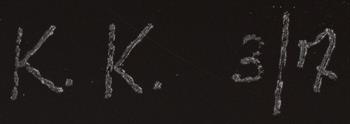0385
Kiki Kogelnik*
(Graz 1935 - 1997 Wien)
„Vanitas (from the series "Venetian Heads I")“
1994
Murano glass
h. 58 cm
monogrammed and numbered: K. K. 3/7
glass manufactory Berengo, Venice
edition: 7 pieces
Provenance
private property, France
Literature
cf. Galerie bei der Albertina-Zetter (ed.), Strictly Kiki perfectly Kogelnik., exhibition catalogue, Vienna 2006, ill. p. 81;
cf. Galerie bei der Albertina-Zetter (ed.), Venetian Heads & Co., exhibition catalogue, Vienna 2010, p. 39.
Original photo certificate by Kiki Kogelnik is enclosed.
Estimate: € 18.000 - 36.000
Hammer price: € 15.000
Auction is closed.
After Kogelnik had worked and experimented with a wide variety of materials (including metal, ceramics, vinyl, plastic and aluminium), in 1994 it was suggested that she collaborate with a glass manufactory in Murano. After initial scepticism, as it was a real challenge to adapt her designs to the handicraft capabilities of glass production, she soon became enthusiastic about this hitherto unfamiliar material. That year, she created her first series, “Venetian Heads I”, which was to be followed by others due to its enormous success. The first heads were produced in a limited edition of only seven pieces, which is why they are particularly sought- after by collectors.
The head, or rather the mask-like face, in which feelings and emotions – reduced to the simplest of forms – are expressed, plays a central role in Kiki Kogelnik’s work. Although often cheerful at first glance, her faces evoke the masks that we wear in our own lives, hidden emotions and the fleeting nature of human existence. Here, the carnival city of Venice naturally comes to mind, as there are few places where the mask is so deeply rooted in the culture and history of a city. Masks symbolise the transient nature of life and the inevitability of death – themes that are also explored in the genre of “vanitas” art.
In Kogelnik’s interpretation, especially in “Vanitas Head”, the viewer is confronted with a fascinating dichotomy. On the one hand, the work emanates a cheerful festive mood due to its aesthetically pleasing material, the polished and highly decorative glass. At the same time, the artist has used the iconic symbol of a skull: reductionist in the extreme, with empty eyes and a gaping mouth, she has placed the mask – which almost appears to be laughing – on a black table which is, in turn, standing on a chicken leg. The title “Vanitas” suggests transience and existential contemplation and makes reference to the traditional vanitas still lifes, which are intended to remind us of the transience of life. The chicken leg can likewise be interpreted as a symbol of fragility and vulnerability. The delicate structure and light weight of these bones contrast with the strength and viability of the living bird – while being simultaneously associated in popular belief with dark magic and diabolical powers, as in the sinister house of the witch Baba Yaga, which stands on chicken legs and can turn itself round.
Here, Kogelnik fuses these contrasting themes together in a masterful manner. Taking a modern, humorous approach, she invites us to question the authenticity of our own identity and to celebrate the fleeting moments of life.
(Ina Waldstein)


